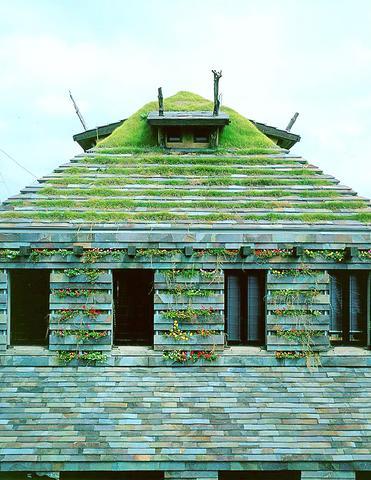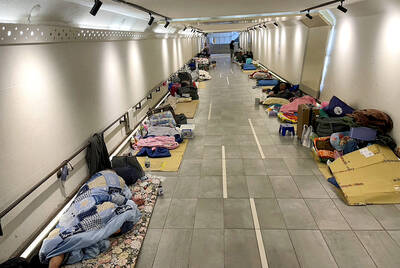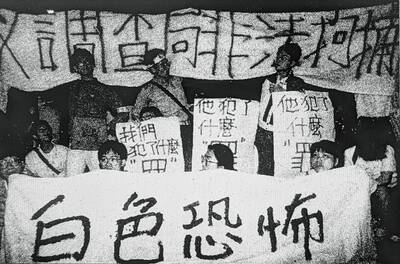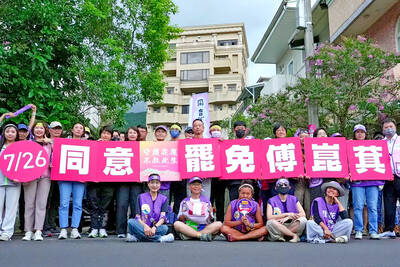My dream is to grow plants on buildings just as the human body grows hair," said Terunobu Fujimori, the architectural historian turned architect who grabbed Japanese media attention in the 1990s with a series of buildings that incorporated living plants.
The names of Fujimori's works -- Chive House, Dandelion House, Single Pine House -- pretty much say it all. Hundreds of pots of chives sway in the breeze on the slanting roof of a one-story cabin in Chive House while the roof of Single Pine House has a pine tree growing on it.

PHOTO:VICO LEE, TAIPEI TIMES
Photos of these and six other buildings by Fujimori in Japan, as well as four models of his architecture, are currently on show in Wildness in Architecture (野蠻建築展) at the National Culture Association (文化總會).

PHOTO COURTESY OF THE NATIONAL CULTURAL ASSOCIATION
For Fujimori, one of the key issues in 21st century civilization is the relationship between the natural and the manmade. His buildings, which incorporate nature, are meant to deal with the issue from a visual and aesthetic perspective.
In addition to his architecture, Fujimori is known for a series of award-winning essays collected in Adventures of Detective Architecture, published in the 1980s. It was the first series of architectural essays to become a national best-seller in Japan.
Convinced that artificial structures and elements in nature can reach a perfect harmony, Fujimori uses steel, mortar and industrial wood to build the inner structures and hidden elements of buildings while placing plants, soil and stone in the more visible locations.
The results are often houses of "ambiguous nationality" which appear naive or even surreal. He planted grass in a diagonal grid all over the roof of Camellia Castle, where a camellia is also planted.
"We often see plants on roofs of modern buildings, but they hardly ever blend in with the architecture. This is because rooftop gardens are usually designed by ecologists, who dislike artificial things. They would rather suppress the artificial to better express the plants," Fujimori said.
"But I think both the plants and the building have to look good. It's not easy, but I want them to get along well."
Apart from building private houses, Fujimori designed the Kumamoto Prefecture Agricultural University Student Dormitory using local timber. Independent pillars, a characteristic of Japanese wooden architecture, are used, but with a twist -- the rows of freestanding, undressed pine columns give people the illusion they're walking in a forest.
Fujimori admits that there are many limits to this incorporation of natural elements. "In Japan, most plants die in winter, so the houses can appear pretty only for a brief time. And when they grow too quickly, the house seems untidy. It takes a lot of work to make these buildings look nice," he said.
Plants in Taiwan, for example, may overwhelm the whole building into which they are integrated because they are "extremely strong".
Wildness in Architecture will show at the National Culture Association located at 15, Chungchin S Rd Sec 2 (

From the last quarter of 2001, research shows that real housing prices nearly tripled (before a 2012 law to enforce housing price registration, researchers tracked a few large real estate firms to estimate housing price behavior). Incomes have not kept pace, though this has not yet led to defaults. Instead, an increasing chunk of household income goes to mortgage payments. This suggests that even if incomes grow, the mortgage squeeze will still make voters feel like their paychecks won’t stretch to cover expenses. The housing price rises in the last two decades are now driving higher rents. The rental market

July 21 to July 27 If the “Taiwan Independence Association” (TIA) incident had happened four years earlier, it probably wouldn’t have caused much of an uproar. But the arrest of four young suspected independence activists in the early hours of May 9, 1991, sparked outrage, with many denouncing it as a return to the White Terror — a time when anyone could be detained for suspected seditious activity. Not only had martial law been lifted in 1987, just days earlier on May 1, the government had abolished the Temporary Provisions Effective During the Period of National Mobilization for Suppression of the Communist

When life gives you trees, make paper. That was one of the first thoughts to cross my mind as I explored what’s now called Chung Hsing Cultural and Creative Park (中興文化創意園區, CHCCP) in Yilan County’s Wujie Township (五結). Northeast Taiwan boasts an abundance of forest resources. Yilan County is home to both Taipingshan National Forest Recreation Area (太平山國家森林遊樂區) — by far the largest reserve of its kind in the country — and Makauy Ecological Park (馬告生態園區, see “Towering trees and a tranquil lake” in the May 13, 2022 edition of this newspaper). So it was inevitable that industrial-scale paper making would

Hualien lawmaker Fu Kun-chi (傅?萁) is the prime target of the recall campaigns. They want to bring him and everything he represents crashing down. This is an existential test for Fu and a critical symbolic test for the campaigners. It is also a crucial test for both the Chinese Nationalist Party (KMT) and a personal one for party Chairman Eric Chu (朱立倫). Why is Fu such a lightning rod? LOCAL LORD At the dawn of the 2020s, Fu, running as an independent candidate, beat incumbent Democratic Progressive Party (DPP) lawmaker Hsiao Bi-khim (蕭美琴) and a KMT candidate to return to the legislature representing